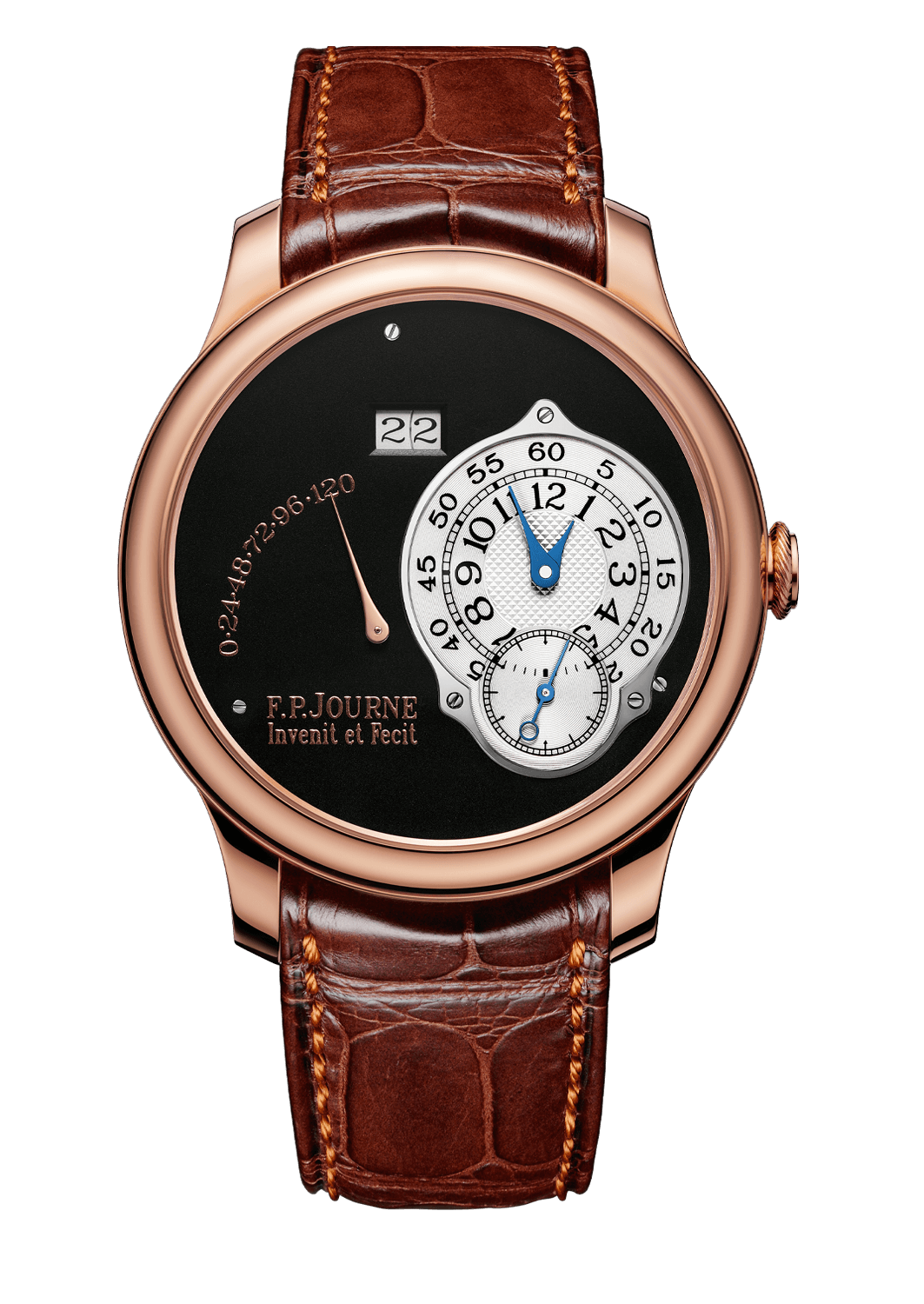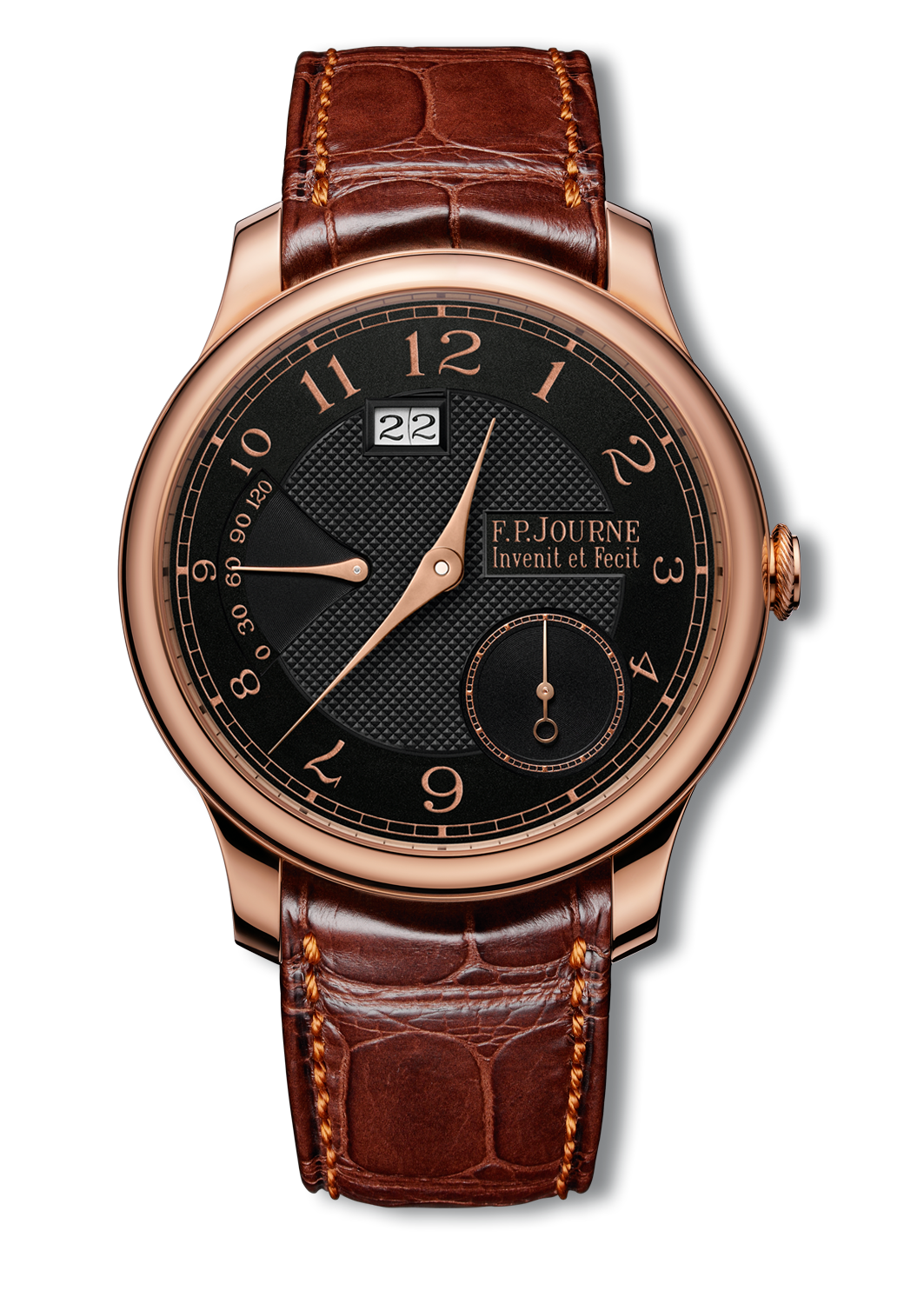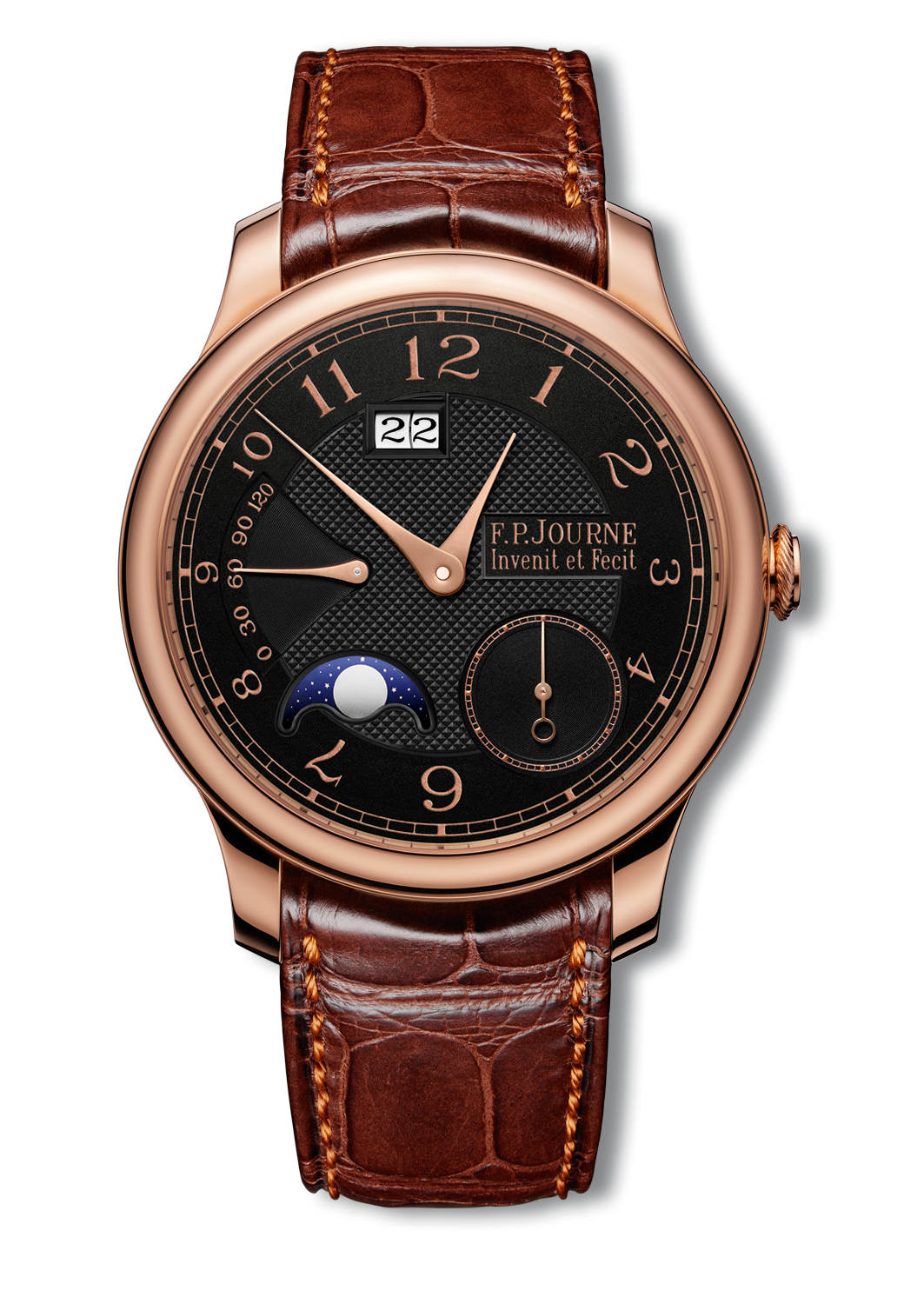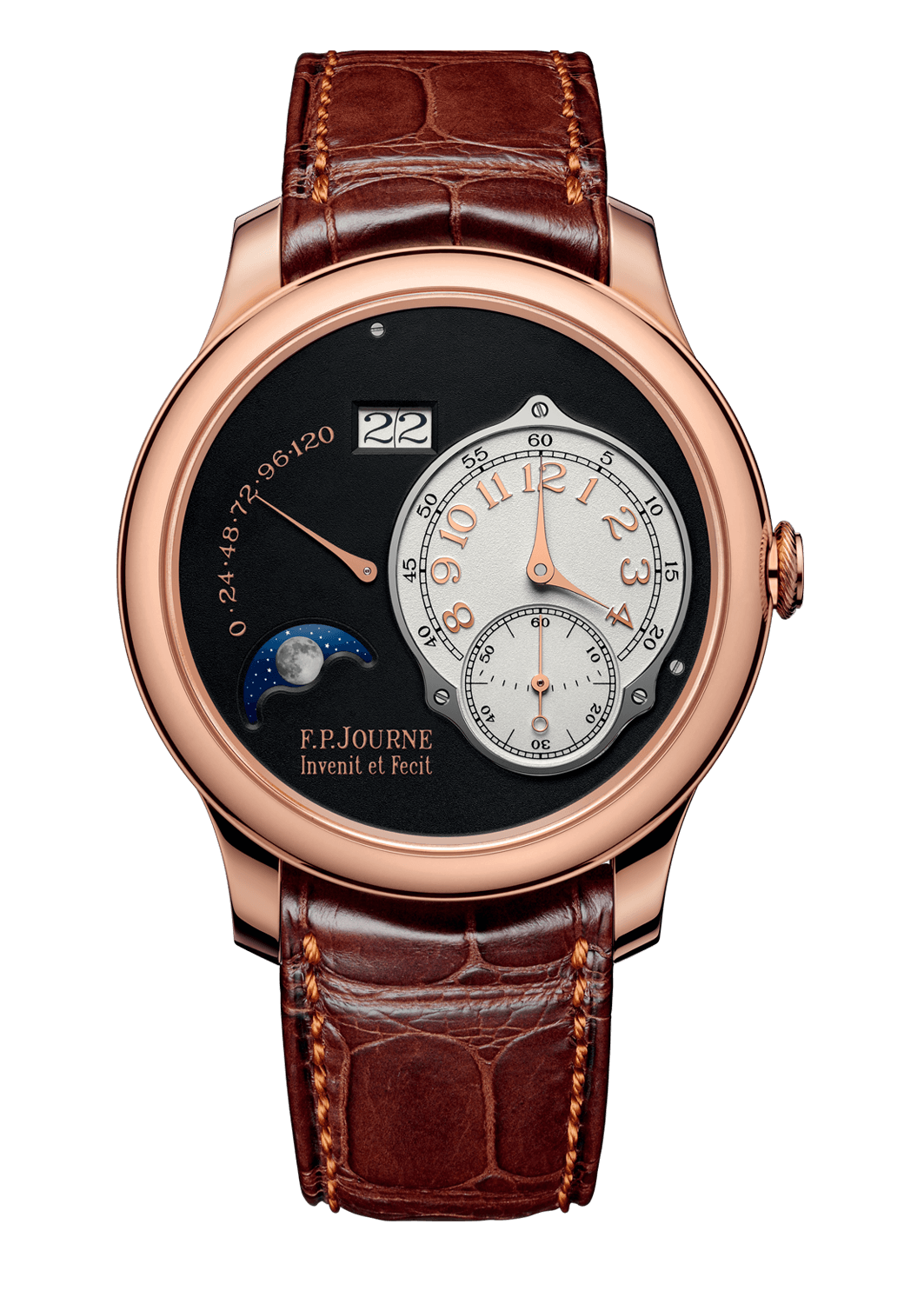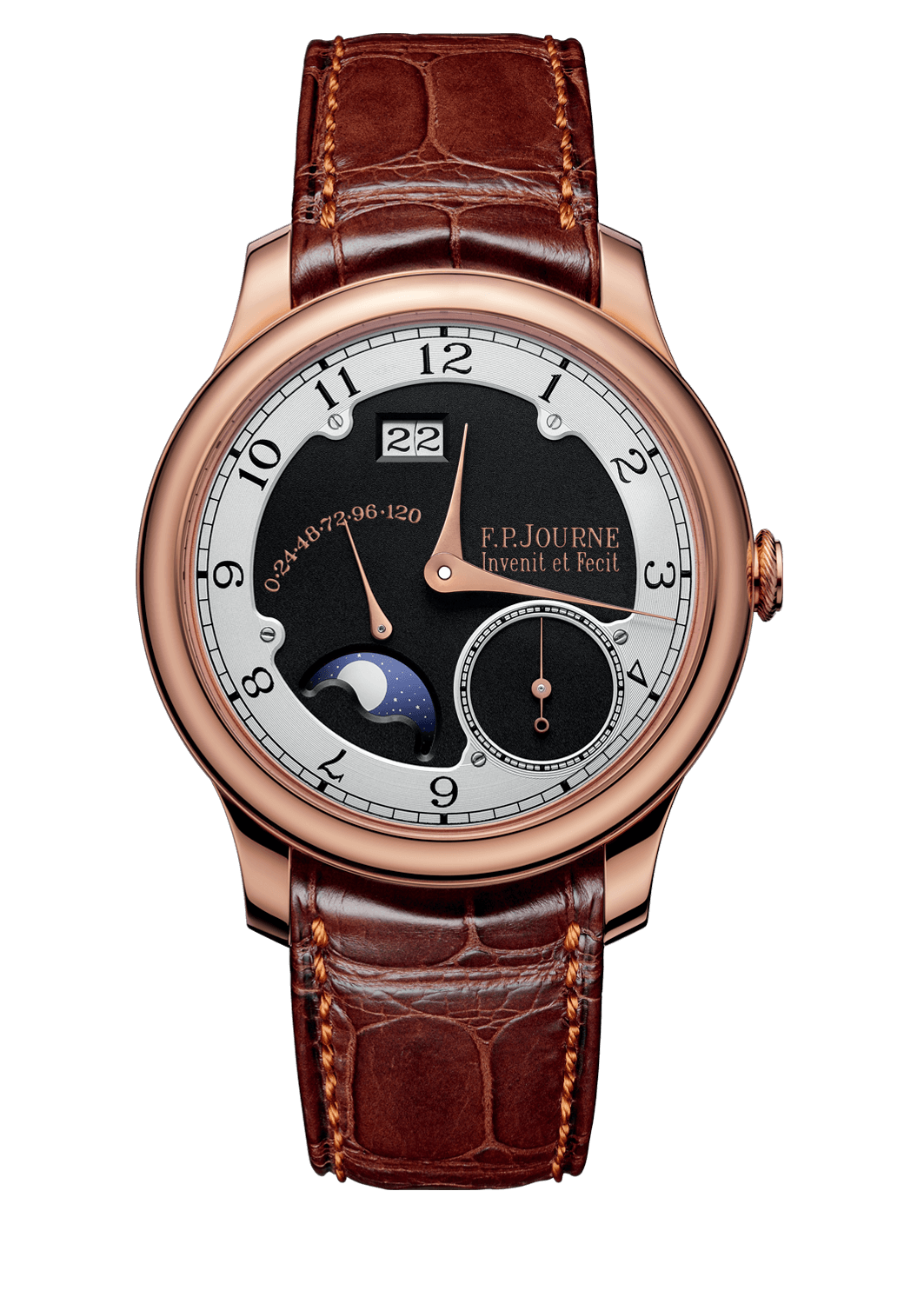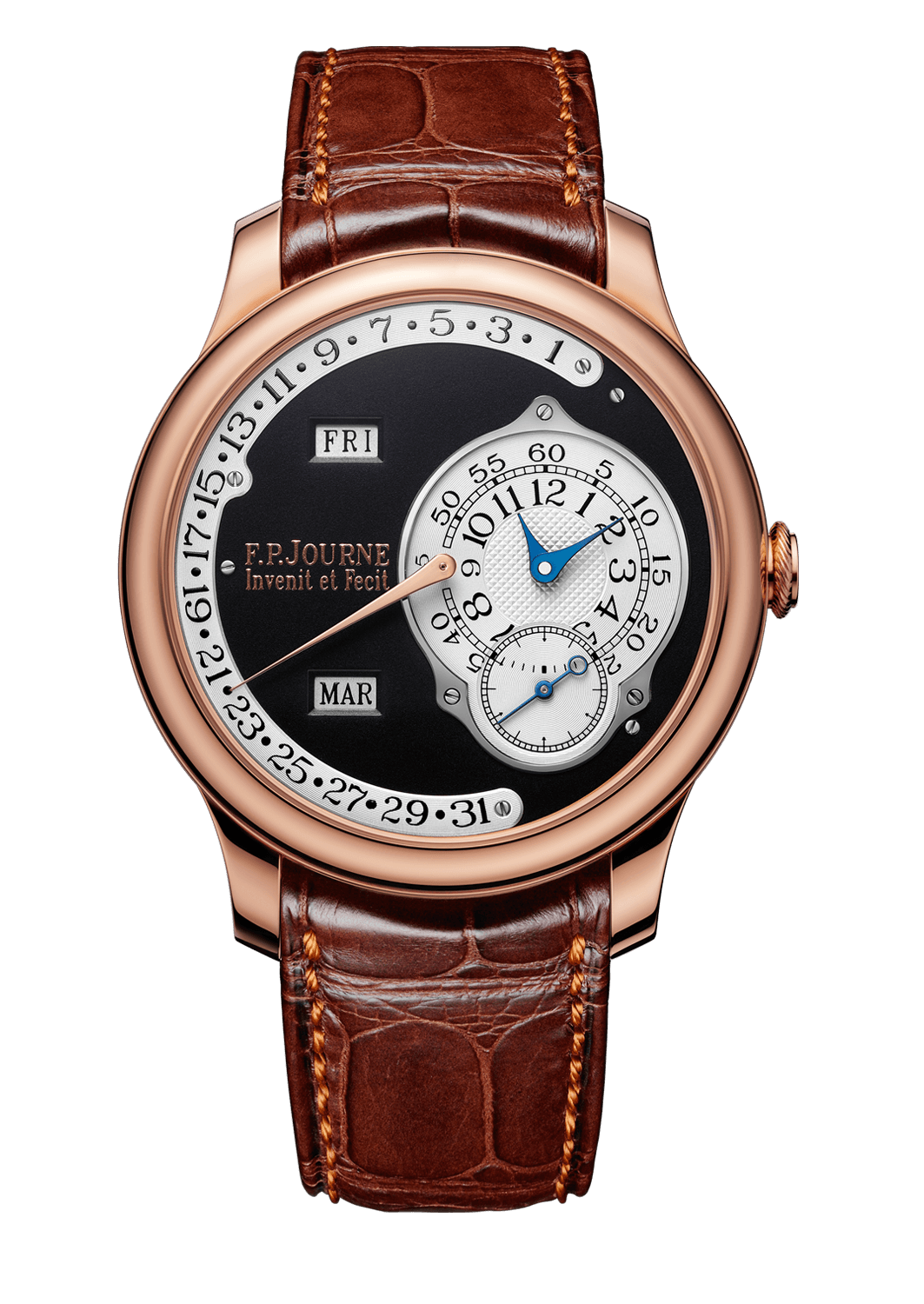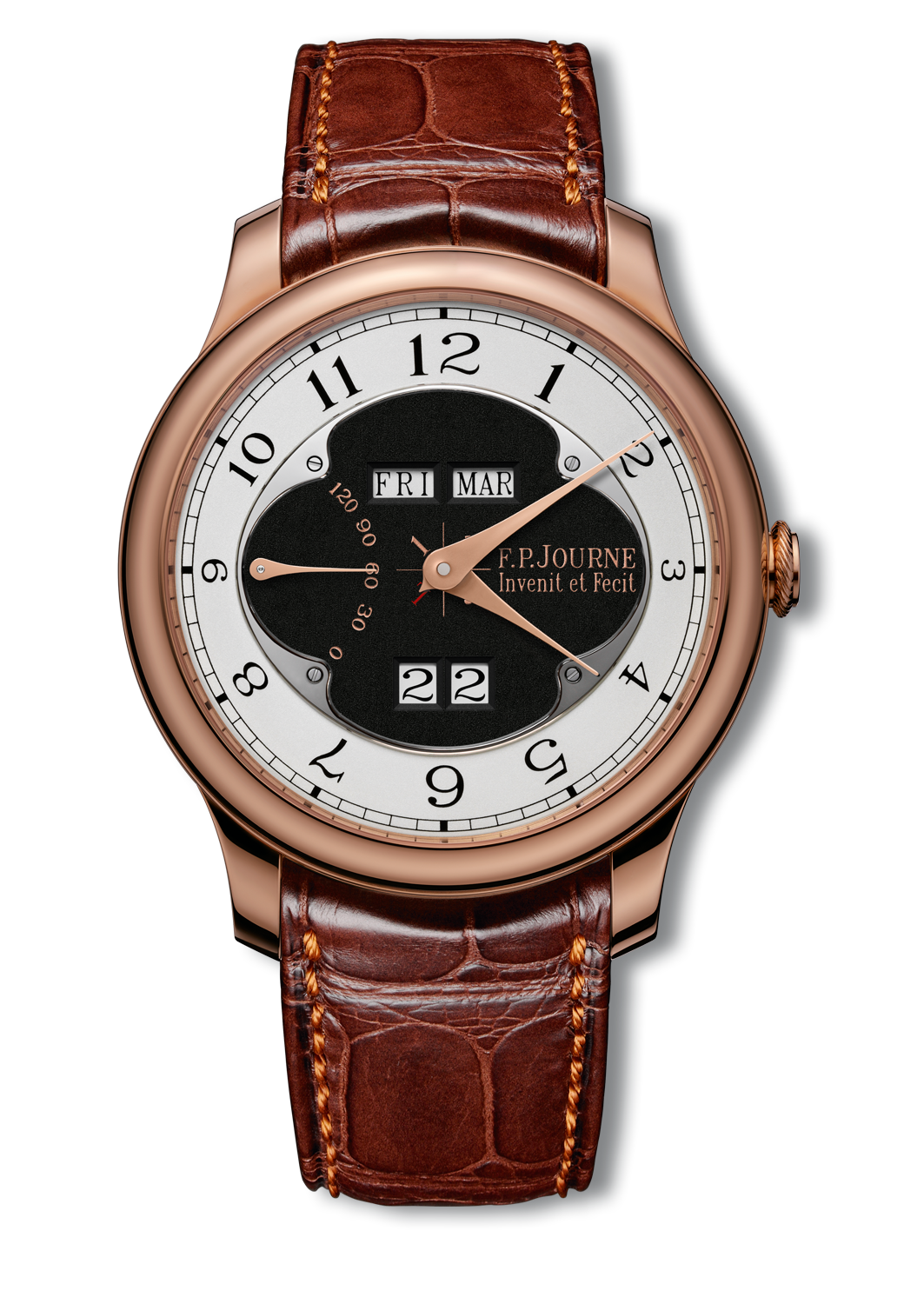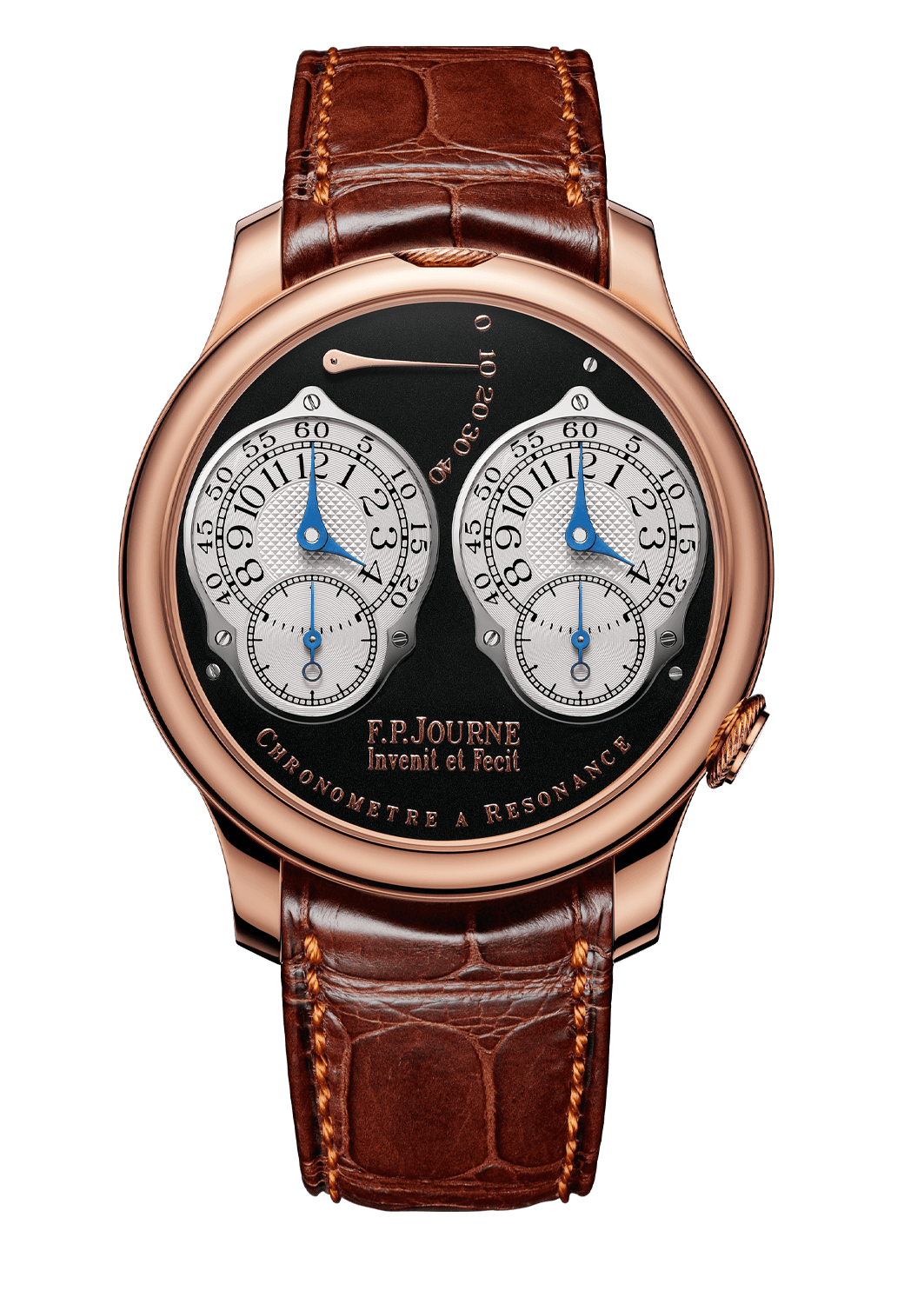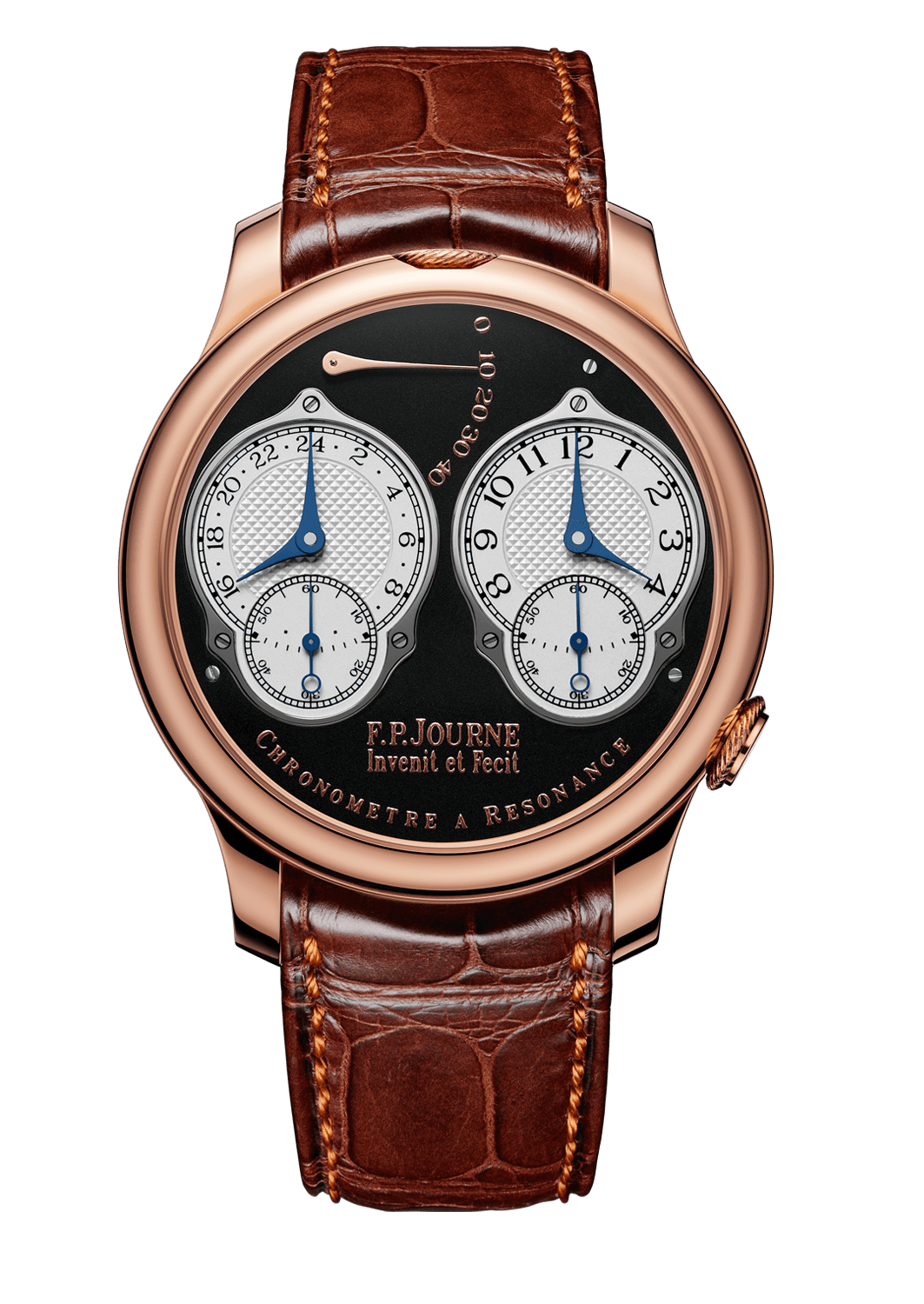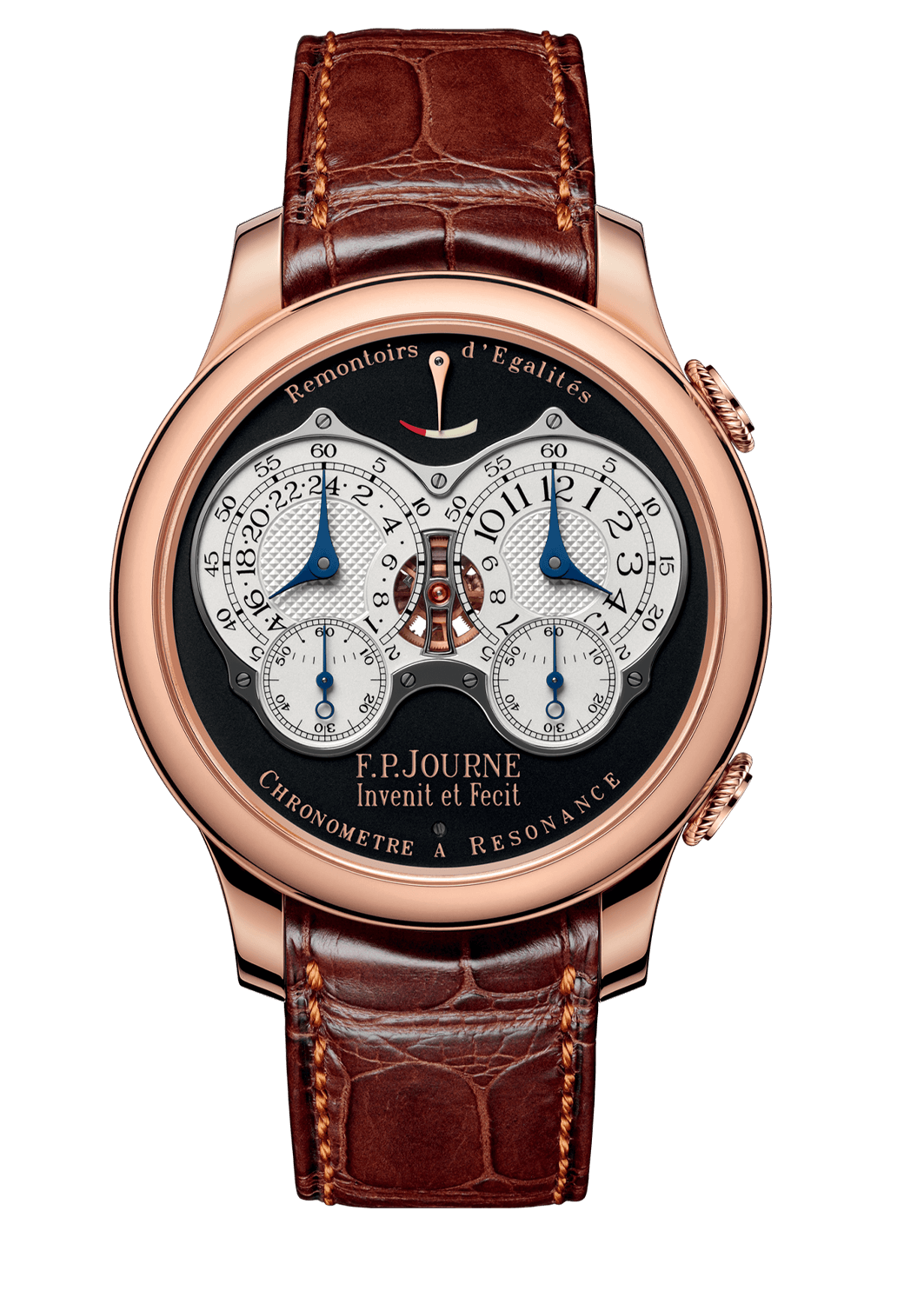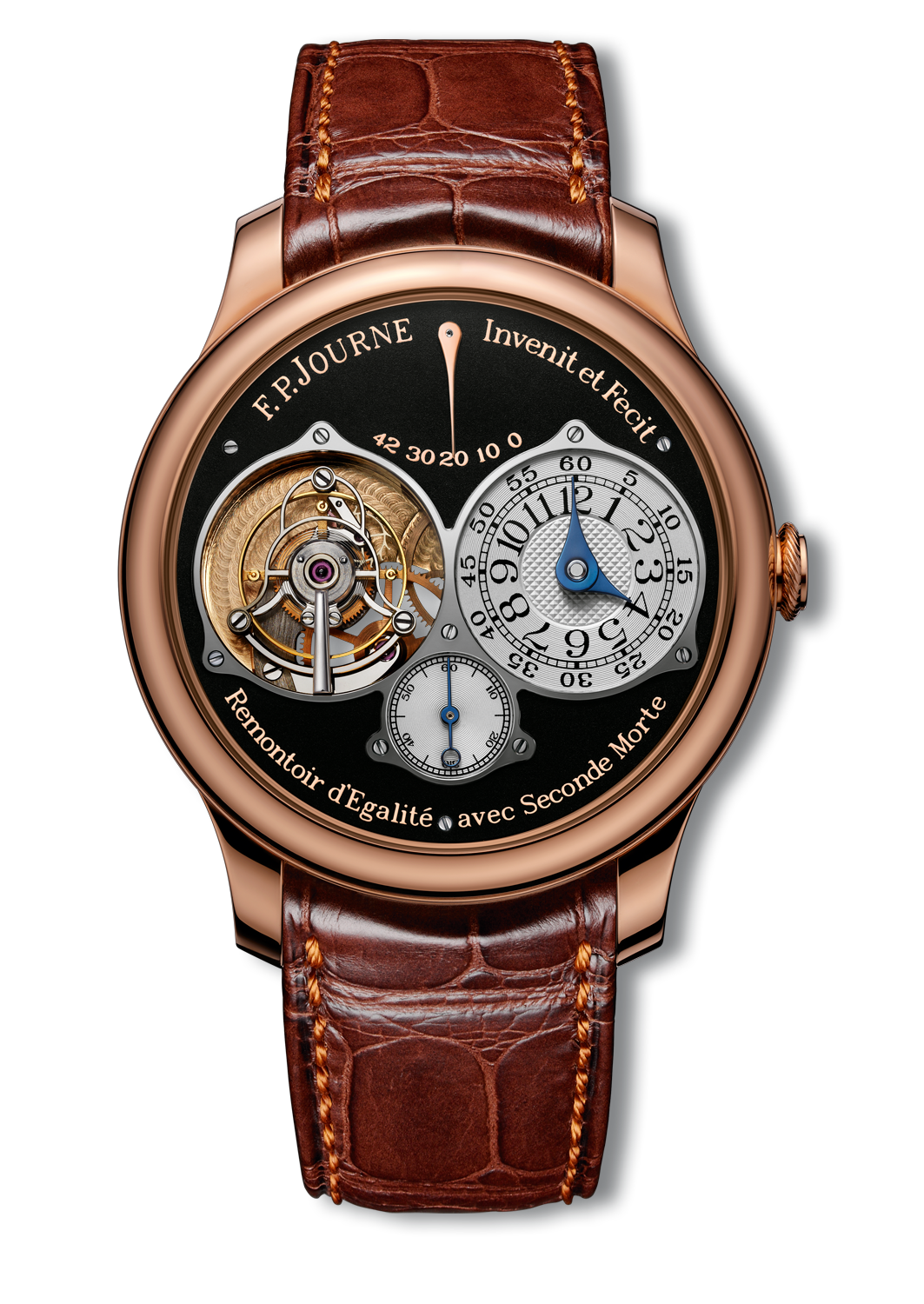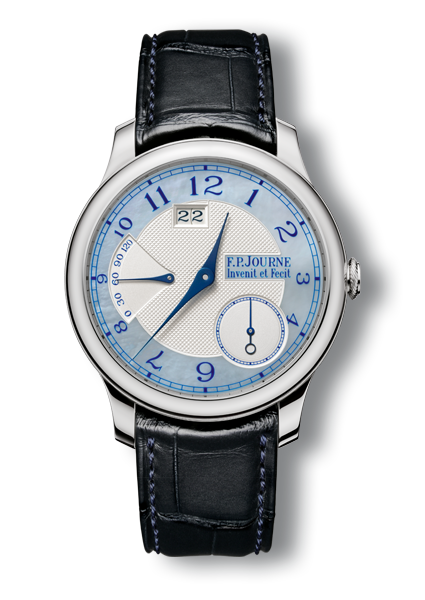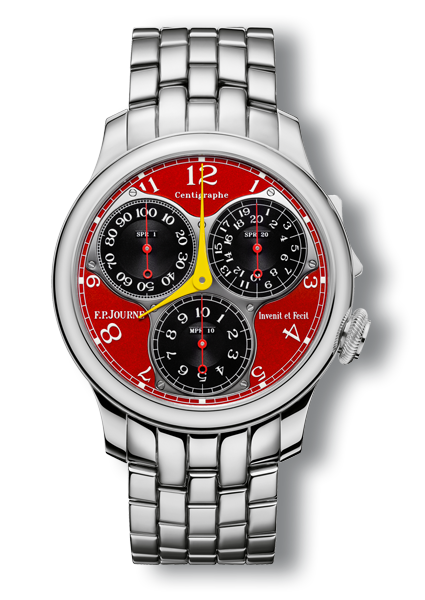Calibre 1304 https://www.fpjourne.com/en/collection/boutique-collection/boutique-edition-chronometre-souverain FP Journe https://www.fpjourne.com/en FP Journe
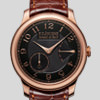
Diameter: 40 mm
Overall height: 8 mm
Dial: blackened guilloché Silver
Hands: 5N gilt Steel
Technical Specifications
- Movement in 18K rose gold : 22 jewels
- Manually wound : 38 turns
- Overall diameter : 30.40 mm
- Casing-up diameter : 29.60 mm
- Overall height : 4.00 mm
- Height of winding system : 2.30 mm
- Diameter of stem thread : S0.90 mm
Four inertia weights
Flat Anachron micro flamed spring
Mobile stud holders
Free sprung
Nivatronic laser-welded to collet
Pinned GE stud
- 0h dial up : 320°
- 24h dial up : 280°
Manual winding
Two mainspring barrels in parallel
Time adjustment via crown in position 2
Pallet escapement with 15 tooth escape wheel
Two position crown
Central hours and minutes
Sub-second at 7h30
56 ± 2 hours
Partly circular grained base plate, with barleycorn guilloché
Polished screw heads, chamfered slots
Pegs with polished rounded ends
Movement without dial: 161
Cased-up on leather strap: 198
- Movement in 18K rose gold : 22 jewels
- Manually wound : 38 turns
- Overall diameter : 30.40 mm
- Casing-up diameter : 29.60 mm
- Overall height : 4.00 mm
- Height of winding system : 2.30 mm
- Diameter of stem thread : S0.90 mm
Four inertia weights
Flat Anachron micro flamed spring
Mobile stud holders
Free sprung
Nivatronic laser-welded to collet
Pinned GE stud
- 0h dial up : 320°
- 24h dial up : 280°
Manual winding
Two mainspring barrels in parallel
Time adjustment via crown in position 2
Pallet escapement with 15 tooth escape wheel
Two position crown
Central hours and minutes
Sub-second at 7h30
56 ± 2 hours
Partly circular grained base plate, with barleycorn guilloché
Polished screw heads, chamfered slots
Pegs with polished rounded ends
Movement without dial: 161
Cased-up on leather strap: 198

Technical description
Movement inspired by early 19th-century marine chronometry.
Twin barrels, in the classic configuration of precision watches, work in parallel to deliver stable power for much of their 56-hour indicated reserve.

Technical description
Movement inspired by early 19th-century marine chronometry.
Twin barrels, in the classic configuration of precision watches, work in parallel to deliver stable power for much of their 56-hour indicated reserve.
Diameter: 40 mm
Overall height: 8 mm
Dial: blackened guilloché Silver
Hands: 5N gilt Steel

Diameter: 40 mm
Overall height: 8 mm
Dial: blackened guilloché Silver
Hands: 5N gilt Steel
Technical Specifications
- Movement in 18K rose gold : 22 jewels
- Manually wound : 38 turns
- Overall diameter : 30.40 mm
- Casing-up diameter : 29.60 mm
- Overall height : 4.00 mm
- Height of winding system : 2.30 mm
- Diameter of stem thread : S0.90 mm
Four inertia weights
Flat Anachron micro flamed spring
Mobile stud holders
Free sprung
Nivatronic laser-welded to collet
Pinned GE stud
- 0h dial up : 320°
- 24h dial up : 280°
Manual winding
Two mainspring barrels in parallel
Time adjustment via crown in position 2
Pallet escapement with 15 tooth escape wheel
Two position crown
Central hours and minutes
Sub-second at 7h30
56 ± 2 hours
Partly circular grained base plate, with barleycorn guilloché
Polished screw heads, chamfered slots
Pegs with polished rounded ends
Movement without dial: 161
Cased-up on leather strap: 198
- Movement in 18K rose gold : 22 jewels
- Manually wound : 38 turns
- Overall diameter : 30.40 mm
- Casing-up diameter : 29.60 mm
- Overall height : 4.00 mm
- Height of winding system : 2.30 mm
- Diameter of stem thread : S0.90 mm
Four inertia weights
Flat Anachron micro flamed spring
Mobile stud holders
Free sprung
Nivatronic laser-welded to collet
Pinned GE stud
- 0h dial up : 320°
- 24h dial up : 280°
Manual winding
Two mainspring barrels in parallel
Time adjustment via crown in position 2
Pallet escapement with 15 tooth escape wheel
Two position crown
Central hours and minutes
Sub-second at 7h30
56 ± 2 hours
Partly circular grained base plate, with barleycorn guilloché
Polished screw heads, chamfered slots
Pegs with polished rounded ends
Movement without dial: 161
Cased-up on leather strap: 198

Technical description
Movement inspired by early 19th-century marine chronometry.
Twin barrels, in the classic configuration of precision watches, work in parallel to deliver stable power for much of their 56-hour indicated reserve.

Technical description
Movement inspired by early 19th-century marine chronometry.
Twin barrels, in the classic configuration of precision watches, work in parallel to deliver stable power for much of their 56-hour indicated reserve.
About
THE BOUTIQUE EDITION WITH BLACK DIAL ON 18K 6N GOLD CASE IS AVAILABLE ONLY IN THE F.P.JOURNE BOUTIQUES AND ESPACES AND FOR ALL F.P.JOURNE MODELS, APART FROM THE STRIKING WATCHES.
What is chronometry?
Consistency in the indication of time.
In the field of mechanical watches, the precision of a chronometer depends on numerous factors. It cannot hope to rival quartz, yet its worth undoubtedly lies in innovation, in horological mechanical poetry, and in research into mechanical subtleties, representing humble bricks that will find their place in the historical wall of horological science.
"Chronometry was invented by the 18th century English and French watchmakers, when their respective governments organised a competition that would reward the first watchmaker capable of making a timekeeper that could be carried on board a ship. Endowed with great precision, it was designed to calculate longitude. The conquest of the world's great oceans and vast uncharted territories was at stake!
In this quest for precision, a portable timekeeper is subject to several natural phenomena liable to be detrimental to its initial rating.
- Thermal variations: the balance and spring assembly is sensitive to changes in temperature, leading to gains when it is cold and losses when it is warm.
- Movements: especially those of the wrist for wristwatches, resulting in abrupt accelerations or decelerations of the balance.
- Geographical situation: two factors are perceptible: first of all latitude, and secondly altitude. In both cases, the gravitational force changes with the friction of the balance pivots, causing losses when moving away from the centre of the earth or gains when drawing closer to it.
- Deterioration of the lubricants: the oils lubricating the escapement harden with age, which in time will cause the watch to gain.
In these four cases, the real precision is not affected; it is only the gauging that has changed! As fas far as F.P.Journe chronometers are concerned, they are adjusted in our workshops in Geneva before being sold throughout the world. Depending on the geographical location of the purchasers, a difference of several seconds may be observed. In each part of the globe, a difference in rating compared with that of Geneva is normal: the gauging of the chronometers changes, but not its precision. Witness the fact that when a timepiece gains two seconds per days and maintains the same gain every day, this actually confirms its extreme precision.
When navigating in the past, captains used to take account of the deviation of their chronometer and integrate it into their calculations to determine the ship's position. If the chronometer showed a deviation corresponding to a one-second gain per day, all that was needed after 30 days was to subtract 30 seconds in order to know the exact time, and so on for each day…"
François-Paul Journe
Technical Specifications
- Movement in 18K rose gold : 22 jewels
- Manually wound : 38 turns
- Overall diameter : 30.40 mm
- Casing-up diameter : 29.60 mm
- Overall height : 4.00 mm
- Height of winding system : 2.30 mm
- Diameter of stem thread : S0.90 mm
Four inertia weights
Flat Anachron micro flamed spring
Mobile stud holders
Free sprung
Nivatronic laser-welded to collet
Pinned GE stud
- 0h dial up : 320°
- 24h dial up : 280°
Manual winding
Two mainspring barrels in parallel
Time adjustment via crown in position 2
Pallet escapement with 15 tooth escape wheel
Two position crown
Central hours and minutes
Sub-second at 7h30
56 ± 2 hours
Partly circular grained base plate, with barleycorn guilloché
Polished screw heads, chamfered slots
Pegs with polished rounded ends
Movement without dial: 161
Cased-up on leather strap: 198
- Movement in 18K rose gold : 22 jewels
- Manually wound : 38 turns
- Overall diameter : 30.40 mm
- Casing-up diameter : 29.60 mm
- Overall height : 4.00 mm
- Height of winding system : 2.30 mm
- Diameter of stem thread : S0.90 mm
Four inertia weights
Flat Anachron micro flamed spring
Mobile stud holders
Free sprung
Nivatronic laser-welded to collet
Pinned GE stud
- 0h dial up : 320°
- 24h dial up : 280°
Manual winding
Two mainspring barrels in parallel
Time adjustment via crown in position 2
Pallet escapement with 15 tooth escape wheel
Two position crown
Central hours and minutes
Sub-second at 7h30
56 ± 2 hours
Partly circular grained base plate, with barleycorn guilloché
Polished screw heads, chamfered slots
Pegs with polished rounded ends
Movement without dial: 161
Cased-up on leather strap: 198

Technical description
Movement inspired by early 19th-century marine chronometry.
Twin barrels, in the classic configuration of precision watches, work in parallel to deliver stable power for much of their 56-hour indicated reserve.

Technical description
Movement inspired by early 19th-century marine chronometry.
Twin barrels, in the classic configuration of precision watches, work in parallel to deliver stable power for much of their 56-hour indicated reserve.
-

Prix montre homme 2005
-
About
THIS MODEL WAS PRODUCED BETWEEN 2010 AND 2024.
THE BOUTIQUE EDITION WITH BLACK DIAL ON 18K 6N GOLD CASE IS AVAILABLE ONLY IN THE F.P.JOURNE BOUTIQUES AND ESPACES AND FOR ALL F.P.JOURNE MODELS, APART FROM THE STRIKING WATCHES. -
Testimony
Chronomètre Souverain
What is chronometry?
Consistency in the indication of time.
In the field of mechanical watches, the precision of a chronometer depends on numerous factors. It cannot hope to rival quartz, yet its worth undoubtedly lies in innovation, in horological mechanical poetry, and in research into mechanical subtleties, representing humble bricks that will find their place in the historical wall of horological science.
"Chronometry was invented by the 18th century English and French watchmakers, when their respective governments organised a competition that would reward the first watchmaker capable of making a timekeeper that could be carried on board a ship. Endowed with great precision, it was designed to calculate longitude. The conquest of the world's great oceans and vast uncharted territories was at stake!
In this quest for precision, a portable timekeeper is subject to several natural phenomena liable to be detrimental to its initial rating.
- Thermal variations: the balance and spring assembly is sensitive to changes in temperature, leading to gains when it is cold and losses when it is warm.
- Movements: especially those of the wrist for wristwatches, resulting in abrupt accelerations or decelerations of the balance.
- Geographical situation: two factors are perceptible: first of all latitude, and secondly altitude. In both cases, the gravitational force changes with the friction of the balance pivots, causing losses when moving away from the centre of the earth or gains when drawing closer to it.
- Deterioration of the lubricants: the oils lubricating the escapement harden with age, which in time will cause the watch to gain.
In these four cases, the real precision is not affected; it is only the gauging that has changed! As fas far as F.P.Journe chronometers are concerned, they are adjusted in our workshops in Geneva before being sold throughout the world. Depending on the geographical location of the purchasers, a difference of several seconds may be observed. In each part of the globe, a difference in rating compared with that of Geneva is normal: the gauging of the chronometers changes, but not its precision. Witness the fact that when a timepiece gains two seconds per days and maintains the same gain every day, this actually confirms its extreme precision.
When navigating in the past, captains used to take account of the deviation of their chronometer and integrate it into their calculations to determine the ship's position. If the chronometer showed a deviation corresponding to a one-second gain per day, all that was needed after 30 days was to subtract 30 seconds in order to know the exact time, and so on for each day…"
François-Paul Journe -
Technical description
Technical Specifications
Movement :- Movement in 18K rose gold : 22 jewels
- Manually wound : 38 turns
Dimensions :- Overall diameter : 30.40 mm
- Casing-up diameter : 29.60 mm
- Overall height : 4.00 mm
- Height of winding system : 2.30 mm
- Diameter of stem thread : S0.90 mm
Balance :Four inertia weights
Flat Anachron micro flamed spring
Mobile stud holders
Free sprung
Nivatronic laser-welded to collet
Pinned GE studAmplitude :- 0h dial up : 320°
- 24h dial up : 280°
Characteristics :Manual winding
Two mainspring barrels in parallel
Time adjustment via crown in position 2
Pallet escapement with 15 tooth escape wheel
Two position crownIndications :Central hours and minutes
Sub-second at 7h30Autonomy :56 ± 2 hours
Decoration :Partly circular grained base plate, with barleycorn guilloché
Polished screw heads, chamfered slots
Pegs with polished rounded endsNumber of Pieces :Movement without dial: 161
Cased-up on leather strap: 198Movement :- Movement in 18K rose gold : 22 jewels
- Manually wound : 38 turns
Dimensions :- Overall diameter : 30.40 mm
- Casing-up diameter : 29.60 mm
- Overall height : 4.00 mm
- Height of winding system : 2.30 mm
- Diameter of stem thread : S0.90 mm
Balance :Four inertia weights
Flat Anachron micro flamed spring
Mobile stud holders
Free sprung
Nivatronic laser-welded to collet
Pinned GE studAmplitude :- 0h dial up : 320°
- 24h dial up : 280°
Characteristics :Manual winding
Two mainspring barrels in parallel
Time adjustment via crown in position 2
Pallet escapement with 15 tooth escape wheel
Two position crownIndications :Central hours and minutes
Sub-second at 7h30Autonomy :56 ± 2 hours
Decoration :Partly circular grained base plate, with barleycorn guilloché
Polished screw heads, chamfered slots
Pegs with polished rounded endsNumber of Pieces :Movement without dial: 161
Cased-up on leather strap: 198
At the heart of the movementAt the heart of the movementBrevet - EP 1 760 544 A1Technical description
Movement inspired by early 19th-century marine chronometry.
Twin barrels, in the classic configuration of precision watches, work in parallel to deliver stable power for much of their 56-hour indicated reserve.
Brevet - EP 1 760 544 A1
Technical description
Movement inspired by early 19th-century marine chronometry.
Twin barrels, in the classic configuration of precision watches, work in parallel to deliver stable power for much of their 56-hour indicated reserve.
Technical Specifications
- Movement in 18K rose gold : 22 jewels
- Manually wound : 38 turns
- Overall diameter : 30.40 mm
- Casing-up diameter : 29.60 mm
- Overall height : 4.00 mm
- Height of winding system : 2.30 mm
- Diameter of stem thread : S0.90 mm
Four inertia weights
Flat Anachron micro flamed spring
Mobile stud holders
Free sprung
Nivatronic laser-welded to collet
Pinned GE stud
- 0h dial up : 320°
- 24h dial up : 280°
Manual winding
Two mainspring barrels in parallel
Time adjustment via crown in position 2
Pallet escapement with 15 tooth escape wheel
Two position crown
Central hours and minutes
Sub-second at 7h30
56 ± 2 hours
Partly circular grained base plate, with barleycorn guilloché
Polished screw heads, chamfered slots
Pegs with polished rounded ends
Movement without dial: 161
Cased-up on leather strap: 198
- Movement in 18K rose gold : 22 jewels
- Manually wound : 38 turns
- Overall diameter : 30.40 mm
- Casing-up diameter : 29.60 mm
- Overall height : 4.00 mm
- Height of winding system : 2.30 mm
- Diameter of stem thread : S0.90 mm
Four inertia weights
Flat Anachron micro flamed spring
Mobile stud holders
Free sprung
Nivatronic laser-welded to collet
Pinned GE stud
- 0h dial up : 320°
- 24h dial up : 280°
Manual winding
Two mainspring barrels in parallel
Time adjustment via crown in position 2
Pallet escapement with 15 tooth escape wheel
Two position crown
Central hours and minutes
Sub-second at 7h30
56 ± 2 hours
Partly circular grained base plate, with barleycorn guilloché
Polished screw heads, chamfered slots
Pegs with polished rounded ends
Movement without dial: 161
Cased-up on leather strap: 198

Technical description
Movement inspired by early 19th-century marine chronometry.
Twin barrels, in the classic configuration of precision watches, work in parallel to deliver stable power for much of their 56-hour indicated reserve.

Technical description
Movement inspired by early 19th-century marine chronometry.
Twin barrels, in the classic configuration of precision watches, work in parallel to deliver stable power for much of their 56-hour indicated reserve.

